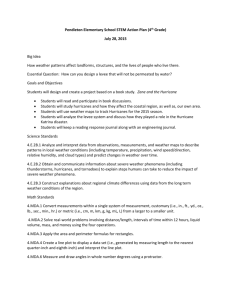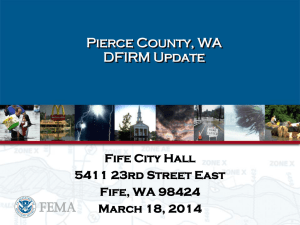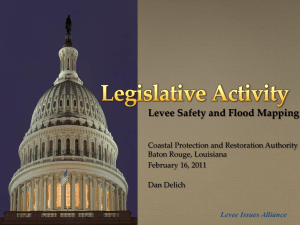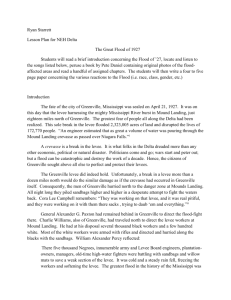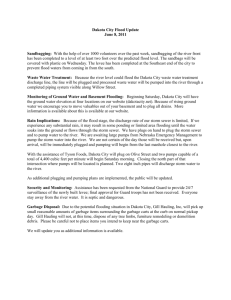Draft Notes, 12/9/2014
advertisement
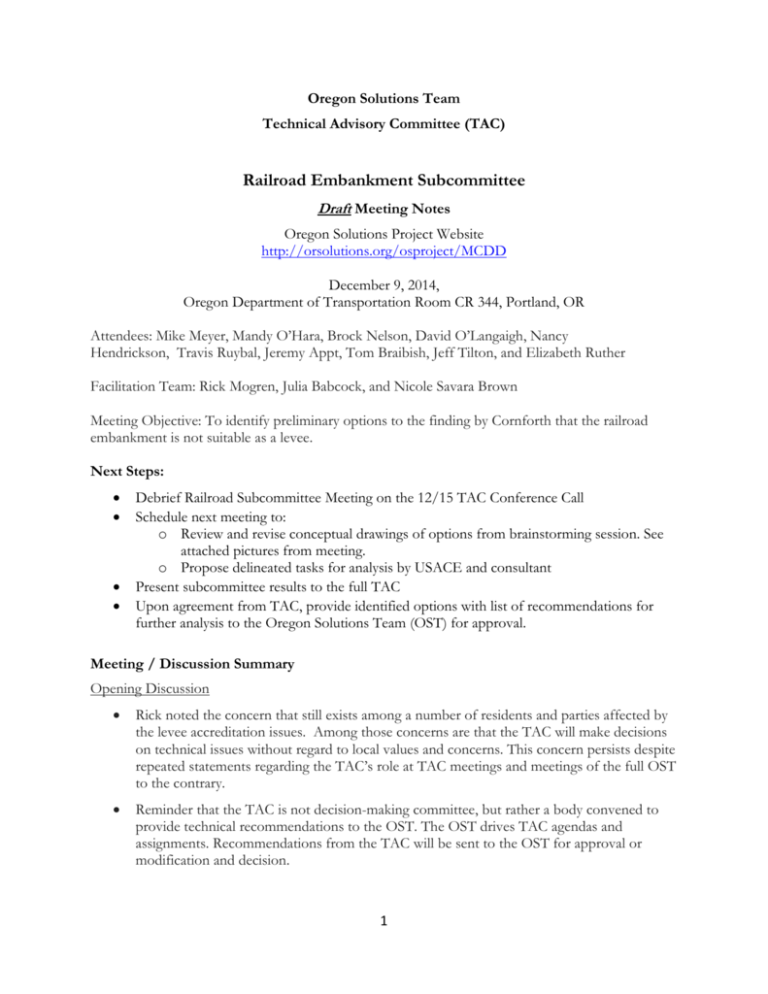
Oregon Solutions Team Technical Advisory Committee (TAC) Railroad Embankment Subcommittee Draft Meeting Notes Oregon Solutions Project Website http://orsolutions.org/osproject/MCDD December 9, 2014, Oregon Department of Transportation Room CR 344, Portland, OR Attendees: Mike Meyer, Mandy O’Hara, Brock Nelson, David O’Langaigh, Nancy Hendrickson, Travis Ruybal, Jeremy Appt, Tom Braibish, Jeff Tilton, and Elizabeth Ruther Facilitation Team: Rick Mogren, Julia Babcock, and Nicole Savara Brown Meeting Objective: To identify preliminary options to the finding by Cornforth that the railroad embankment is not suitable as a levee. Next Steps: Debrief Railroad Subcommittee Meeting on the 12/15 TAC Conference Call Schedule next meeting to: o Review and revise conceptual drawings of options from brainstorming session. See attached pictures from meeting. o Propose delineated tasks for analysis by USACE and consultant Present subcommittee results to the full TAC Upon agreement from TAC, provide identified options with list of recommendations for further analysis to the Oregon Solutions Team (OST) for approval. Meeting / Discussion Summary Opening Discussion Rick noted the concern that still exists among a number of residents and parties affected by the levee accreditation issues. Among those concerns are that the TAC will make decisions on technical issues without regard to local values and concerns. This concern persists despite repeated statements regarding the TAC’s role at TAC meetings and meetings of the full OST to the contrary. Reminder that the TAC is not decision-making committee, but rather a body convened to provide technical recommendations to the OST. The OST drives TAC agendas and assignments. Recommendations from the TAC will be sent to the OST for approval or modification and decision. 1 Request TAC member support in addressing these anxieties about TAC activities. Please assist in letting folks know that the TAC and OST are working to be as transparent as possible, that all meetings are open for public attendance, that minutes are reviewed and posted to the publicly available website, and that the TAC will report out summaries of each TAC meeting at OST meetings. Travis noted that the City of Portland has a lot at stake in PEN 1 and wants to have an active voice in the discussion of alternatives and any ultimate decisions by the OST. The City staff have held internal meetings with Mayor’s Office, PBOT, Parks, and BES and agreed to a draft set of values for the levee project. See draft list of values at Attachment 1. The final version will be shared as soon as available. PEN 1 Technical Summary- Mandy O’Hara and Mike Meyer. Mandy provided an overview of the status of the levee issues facing PEN 1; Mike provided some of the technical findings from Cornforth’s levee assessment report regarding subsurface soil conditions: On the I-5 interstate highway runs north-south along the east side of PEN 1. The I-5 embankment is considered “high ground” between PEN 1 and PEN 2, and not a levee per certification. USACE does not consider the I-5 roadway embankment an authorized levee project. PEN 1 consists mostly of city property, with Metro, the Port of Portland, the Railroads (U.P., BNSF), and Graphic Packaging as other major landowners. Need to provide map with property ownership shown. Water could flood PEN 1 from either the Columbia slough, Columbia River, or backwater from flooding down the Willamette River. Mandy noted a significant issue for MCDD regarding the existing pump station. The pumps exist to remove water that collects inside the levee system. Those pumps are old and may need to be upgraded or moved depending on the alternative selected. The stormwater component, of how the district is retaining water, should be addressed in PEN 1 alternatives. The financing of replacement pumps is an issue as well, given that much of the property within PEN 1 is open space and that city property has a low taxable rate. Corps found area where large excavation occurring without proper permits where sand has been removed. Local drainage from parking lot where plastics company warehouse there was a storm drain protecting water, infiltrating it. Mike: Noted that the bore tests found 12 .5 feet of fill, placed potentially after 1948 flood. Under this is an intermixed layer of naturally occurring soft silt to loose sand down to 56 feet. This silty-sand mix yielded “blow counts” of 0 (zero), meaning it has no strength to hold significant weight. Consequently, any setback levee would likely experience significant settlement for the first few years after construction. This soil condition likely exists throughout the PEN 1 area. As noted in the levee assessment report, the settlement under the existing levees occurred long ago. Furthermore, adding new fill next to railroad embankment or any existing structures may cause settlement that could affect adjacent facilities / tracks. Subsurface conditions should therefore be a factor for the consultant to look at for potential settlement impacts on the railways, roads, buildings, etc. 2 The question was asked as to how a 100 year (1% probability) flood would affect PEN 1 should the railway embankment fail. [POST MEETING NOTE: The Corps provided an unofficial inundation map after the meeting in response to this request; that map is at Attachment 2] PEN 1 is built to 100 year flood and RIP program north and south portion of levee 1876 flood, Railroad embankment 100 year flood. Railroad 32 feet north and south side 35 feet. 35 feet standard for levees for 100 year level of protection. Jeremy: Recommends everyone on the subcommittee be familiar with the Corps’ Section 205 study, which included cost/benefit assessments of different flood protection levels. The study found a positive benefit/cost ratio for the 100 year standard, but a negative ratio for any level of protection above that. Could freshen economic assumptions, but PEN 1 hasn’t change land use characteristics much and so the results would not likely change. As is levees should be accepted into the RIP program. DRAFT RR EMBANKMENT OPTIONS: DRAFT OPTION 1 Flood Plain Option 1 (Flood Plain) consists of levees and/or flood walls constructed to protect the developed area along Marine Drive in the north and the EXPO Center and racetrack in the southeast to the 100 year (1% probability flood) level of protection. The remaining area in PEN 1, which consists mostly the golf course, would not be protected. See Map 1. There are four sub-options. MAP 1: Option 1 3 Option 1a: Do nothing with the south levee. o Leave south levee in place, allowing occasional flooding sometimes where and if the railroad embankment fails. o Railroad embankment out of system. o The south levee may or may not be maintained. If not, it would eventually deteriorate. Option 1b: Reopen the flood plain o Remove the south levee, reopening the floodplain to seasonal flooding from the Columbia slough Option 1c: Controlled flooding o Leave the south levee in place, but install structures like tide gates that would manage water coming in and out if have to replace pump station. Option 1d: Protect Max line. o Install flood wall and/or levee to protect the MAX line to the east from 100 year (1% probability) flooding. o This sub-option could be implemented with sub-options 1a, 1b, or 1c. Issues: Pump station/water removal; controlled flooding design; benefit/costs of allowing the golf course to flood; cost of flood walls and levees around north and southeast facilities; necessity of protecting the MAX line. Discussion Around Option 1: Need to know consequences of a do nothing scenario. One option waits waits for either the RR embankment to fail, the second purposefully allows flooding through removal of the south levee or installation of tide gate-like structures. District would need to discuss the disposition and relocation of the pump station because no removal of water without adequate funding. Golf course and PRI facilities are valuable assets to the city. Broad alternatives for policy decision, Columbia slough habitat for salmon has a lot of value. Portland Harbor Superfund could perhaps provide funding stream for restored habitat. Cross levee not authorized Corps project. The MAX line elevation appears as low as 20-28 feet along the Expo road. The MAX line was not considered in the 205 study. 4 Breaching levee intentionally, allow flooding. Breached levee overtopping can be catastrophic if failed. Installation of control structures (tide gates) would minimize risk of overtopping. 2 major railroads, controlled failure preferred. U.P. could contribute funds to protect area. Preserves ability to move today and expand. Risk railroad embankment failure seepage underneath or stability failure or wooden trestle, where didn’t fail in 1948. Seasonal flooding one thing, major event could create a lot of liability on city. Deferring costs and creating hazardous concerns. Does it matter where you let the water in? Generally even exposure on 3 sides (except east side) would help reduce tension. Need to determine distance of setback of new levees from facilities to determine settlement issues, if any. 1948 failure-duration of floods factor. The Columbia River flooded into Smith and Bybee lakes and water sat against the RR embankment for about 2 weeks. Failure due to seepage under the embankment from piping. 1948 flood level was 36.3 feet. Note that the 1948 flood occurred before the Columbia River Treaty and construction of flood storage dams in Canada. ODOT has concerns regarding I5 being considered as a levee. TRIMET should be at the table for MAX discussion especially. USACE has not authorized everything, ODOT built embankments with Corp permits for 2 sections on the east. Not clear how much designed as levees. Places that want to fill in wetlands, mitigation different than BPA fish units. Research revenue possibilities. Restore to fish habitat as opposed to floodplain. Liz and Nancy can look into floodplain crediting potential. Across river on WA side, working with lower Columbia estuary partnership working to get environmental benefit units for internal flooding. Setback levees to protect interior of the district. Similar subsurface. 20 foot high 1 mile 8-10 million. Option to rebuild the railroad embankment to levee standards should be on the table, even if we know politically not feasible. Need to consider all options. 5 DRAFT OPTION 2 Setback Levee East of Railroad Embankment Option 2 consists of building a setback levee and/or floodwall parallel to and east of the current railroad embankment. See Map 2. There are two sub-options. MAP 2: Option 2 Option 2a. o Variation on setback levee east of railroad embankment. Keying into railroad. Option 2b. o Western side Portland Blvd form of floodwall. Discussion Around Option 2: Need to determine distance of setback from railroad embankment to avoid settlement. Variability whether railroad sees benefit. Closer to tow of slope, less problematic from operating perspective. Inside RR-access to PP&R right-of-way. Issues: right-of-way for construction, setback distance, use of a flood wall vs. levee, settlement issues. Use of wall instead of embankment or pay railroad to settle tracks. Slurry injection into the subsurface soils in those areas to reduce the necessary setback distances. Deep soil mixing to blend in native soil and slurry mix. Concrete engineered flood wall option to reduce setback-doesn’t weigh much and wouldn’t have large footprint. 6 Note the FEMA requirement for a 3 foot freeboard above the 100 year (1% probability) flood level. Note that Cornforth ran a series of cross sections to show how levee would look. Existing railroad centerline 0 on bottom axis. Impedes existing ground, variation. PAS-USACE role. Railroad embankment only. $118,000. Cost to benefit for the environment for overall system. In-kind work designated from MCDD for environmental work. CRT studied 100 miles of levee system fragility curve along different networks. Best to conduct cost/benefit. Leave south levee intact in order to provide the same level of protection as now. Gates that could provide access through railroad property. May be able to pass underneath existing railroad lines. Coming in between rail with wall with closure structure. Cross sections of different scenarios that show property lines and impacts. Issue with O and M agreements for any structure on railroad property. Note that Cornforth did s conceptual sketch of this option; see Map 3. Map 3: Cornforth Sketch of Option 2 7 DRAFT OPTION 3 Setback Levee West of RR Embankment Option 3 consists of constructing a setback levee and/or flood wall parallel to and west of the RR embankment. See Map 4. There are two suboptions. Map 4: Option 3 Option 3a: Construct flood wall between RR and the highwayOption 3b: o Construct levee and/or flood wall to the east in the northern section of the embankment. Discussion Around Option 3: What would it take to reinforce railroad as levee on west side of road or railroad? Track all at the same elevation. May reduce length of levee. However, still need south portion of levee. Track also across 3a option. Need to know elevations. City doesn’t want to preclude already adopted goals. Brock, good brainstorm, as we move forward will make sure to bring in all the right railroad folks. 8 Final Thoughts The 3 different alternatives development was productive, good discussion. Provide railroad maps with clear delineation of property lines. Respect everyone has organizational interests that may come out in these discussions. Reminder that the Oregon Solutions Team will make the policy decisions. Attachments: 1. 2. 3. 4. Draft City of Portland Statement of Values Levee System Form 1-PEN 1 Levee System Form 1-PEN 2 100 Year Flood Inundation Map of PEN 1 9

